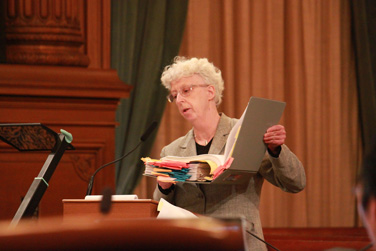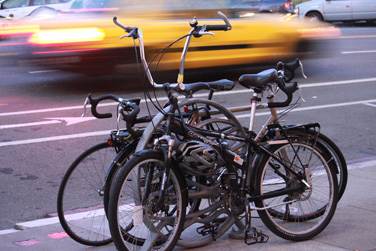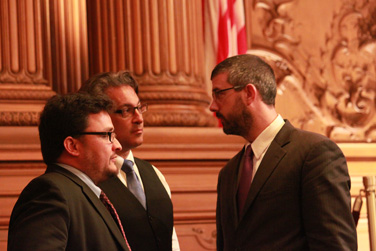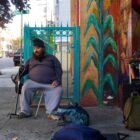 |
| Bicycle plan critic Mary Miles worked long and hard to challenge final approval. Photo by Max Rosenblum/The Public Press. |
A unanimous decision by the Board of Supervisors Tuesday night to reject appeals and approve the environmental impact report for the 45-project Bike Plan brought a sigh of relief from bicycle advocates.
Bicyclists have been waiting to have their day in court since 2006, when a lawsuit challenged expansion of the city’s bicycle network, warranting a lengthy environmental study and essentially tying the hands of the city’s Municipal Transit Agency.
The lawsuit imposed a now three-year-old injunction which prevents physical streetscape changes for the sake of bicycle improvements. With the approval of the evironmental impact report, the city attorney can now ask the court to lift the injunction.
Cycling enthusiasts celebrated at the end of June when the Planning Department and the transit agency approved the hefty environmental impact report and adopted 45 out of 56 projects in the Bike Plan package, which would double the number of bike lanes in the city and install hundreds of new bicycle racks.
But a relatively new amendment to the California Environmental Quality Act — which required the environmental study — opened the door to an appeals process and blocked a fast-track finish for the Bike Plan.
As of January 1, 2003, any type of CEQA decision, whether it be the need for an environmental impact report, a negative declaration or an exemption, became appealable to the Board of Supervisors. This essentially removed the finality from Planning Department decisions — in this case, the Planning Commission had unanimously approved the final environmental impact report on June 25.
This appeals process has seen some abuse, according to the planning department, with appellants filing at the last minute and submitting documents full of “recycled information” to the board’s clerk right up until the time of the hearing.
 |
| Photo by Max Rosenblum/The Public Press. |
“I think there’s a pattern here,” Bill Wycko, the department’s environmental review officer, said. “There’s an appeal a month ago, several weeks ago, and it’s brief. It doesn’t raise any new issues. Today, as the hearing is starting, we get 40 pages … requiring you to postpone your hearing, requiring you to reverse the planning commission. That’s kind of the MO [modus operandi] we’ve seen throughout this process.”
Wycko said, however, that the board clerk has no way of enforcing that documents be submitted a week before the hearing.
An environmental study was needed to determine what, if any, negative impacts the project would have on traffic, and how they should be mitigated.
Attorney says report is ‘incomprehensible’
Attorney Mary Miles, who represented the litigant in the original 2006 lawsuit, has been scouring documents to uncover any legal technicality that could lengthen the process. She said the environmental report was "incomprehensible" and a “morass of compounded cut and paste, cross-referenced, encoded somethings that say nothing."
As she stood at the podium, Miles suggested that the board table the issue until they could devote their attention to it on the grounds that there wasn’t enough time that night.
It had been a marathon session for the board, which had just finished a three-plus-hour appeal hearing on the Drew School. But, the board was committed to making a decision on the Bike Plan, even if it had been almost 8 p.m. by the time the debate kicked off.
“We and the people have not had sufficient time” to digest the voluminous documents and voice concerns, Miles said. “We feel you owe it to us and to the public, and the law requires that you read this comment and study it and give it your full consideration.”
“I would suspect that none of you have even looked at the EIR,” she said.
Wycko later questioned this argument, given the “litany of comments” the department received from Miles and others in a hearing file that was 4-inches thick.
“You don’t prepare a 40-page document if you haven’t had a chance,” Wycko said.
Possible disruptions worry South Beach group
 |
| Supervisors David Campos, Ross Mirkarimi and Chris Daly convened at the meeting where the bicycle plan was approved. Photo by Max Rosenblum/The Public Press. |
Representing a group of South Beach merchants and neighbors, a second appellant, Katy Liddell, had concerns rooted in possible disruptions posed by upgrades to the Second Street bicycle route.
“Our objection is to the way that Second Street has been redesigned to accommodate the bike lanes,” Liddell said. In particular, the elimination of left-hand turns in both directions from Market to King streets was especially disturbing, she said. The Second Street plan was tabled by the MTA on June 26, but residents still wanted their concerns to be heard.
Liddell disputed an MTA finding that traffic calming would occur along the street; she said the redesign "will likely result in additional frustration and aggressive driving” that will put all users at risk.
Public comments from South Beach neighbors and merchants echoed the same sentiment, and included concerns about increased traffic and time wasted looking for parking.
Supervisor Sean Elsbernd, who frequently chimes in at board meetings on procedural matters, pointed out during the Planning Department’s presentation that the Second Street plan was still included in the environmental report, even if it was tabled by the MTA.
Although Second Street has been an official bicycle route since 1997, neighbors in South Beach said they have been fighting to be heard on what they considered to be a disruptive plan with little official outreach. Despite 50 hours of independent door-to-door outreach conducted by the bicycle coalition, they have been waiting for the MTA’s word, which Elsbernd helped deliver.
He was able to get such a verbal commitment from the agency — SFMTA planning representative Bridget Smith said “yes, we will absolutely work with the neighbors.”
Don Willenburg, a Pacific Heights resident who works as a lawyer in the Financial District, countered the argument of South Beach neighbors who all were looking to maintain traffic flow around the Bay Bridge:
“This city is not about how fast you can drive through neighborhoods, it’s about how you can enjoy and live in neighborhoods.”
In the end, Leah Shahum, executive director of the bicycle coaltion, said she was “thrilled” that neighbors and bicycle advocates were on the same page regarding having bicycle lanes on Second Street, and that they’ll continue to work with residents to reach a compromise.
Bicycle-operated shredder
As her final comment for the evening, Miles said that the city could recoup some of the money spent on the report if they “hire the bicycle coalition to create a bicycle-operated shredder or something like that.”
Before the board wrapped up their official business, Supervisor Chris Daly asked Board President David Chiu if they could look into that.
“No one’s up for the shredder? I’m up for the shredder.”










